 |
Agra & Varanasi |
 |
 Agra fort - Agra Fort :
Agra fort - Agra Fort : is a UNESCO World Heritage site located in Agra.The fort is also known as Lal Qila, Fort Rouge and Red Fort of Agra. It is about 2.5 km northwest of its much more famous sister monument, the Taj Mahal. The fort can be more accurately described as a walled palatial city. It is the most important fort in India. The great Mugals, Humayun, Akbar, Jehangir, Shah Jahan and Aurangzeb lived here, and the country was governed from here. It contained the largest state treasury and mint. It was visited by foreign ambassadors, travelers and the highest dignitaries who participated in the making of history in India. Realizing the importance of its central situation, Akbar decided to make it his capital and arrived in Agra in 1558. His historian, Abdul Fazal, recorded that this was a brick fort known as 'Badalgarh' . It was in a ruined condition and Akbar had it rebuilt with red sandstone from Barauli area in Rajasthan. Architects laid the foundation and it was built with bricks in the inner core with sandstone on external surfaces. Some 1,444,000 builders worked on it for eight years, completing it in 1573.
|
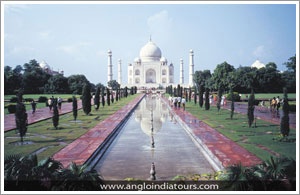 Taj Mahal- Agra :
Taj Mahal- Agra : Taj Mahal, the pinnacle of Mughal architecture, was built by the Mughal emperor Shah Jahan (1628-1658), grandson of Akbar the great, in the memory of his queen Arjumand Bano Begum, entitled ‘Mumtaz Mahal’. Mumtaz Mahal was a niece of empress Nur Jahan and granddaughter of Mirza Ghias Beg I’timad-ud-Daula, wazir of emperor Jehangir. She was born in 1593 and died in 1631, during the birth of her fourteenth child at Burhanpur. Her mortal remains were temporarily buried in the Zainabad garden. Six months later, her body was transferred to Agra to be finally enshrined in the crypt of the main tomb of the Taj Mahal.
The Taj Mahal is the mausoleum of both Mumtaz Mahal and Shah Jahan. The mausoleum is located on the right bank of the river Yamuna at a point where it takes a sharp turn and flows eastwards. Originally, the land where the Taj Mahal presently stands belonged to the Kachhwahas of Ajmer (Rajasthan). The land was acquired from them in lieu of four havelis as is testified by a court historian, Abdul Hamid Lahauri, in his work titled the Badshah-Namah and the firmans (royal decrees). For construction, a network of wells was laid along the river line to support the huge mausoleum buildings. Masons, stonecutters, inlayers, carvers, painters, calligraphers, dome-builders and other artisans were requisitioned from the whole of the empire and also from Central Asia and Iran. While bricks for internal constructions were locally prepared, white marble for external use in veneering work was obtained from Makrana in Rajasthan. Semi-precious stones for inlay ornamentation were brought from distant regions of India, Ceylon and Afghanistan. Red sandstone of different tints was requisitioned from the neighbouring quarries of Sikri, Dholpur, etc. It took 17 years for the monument complex to be completed in 1648.
|
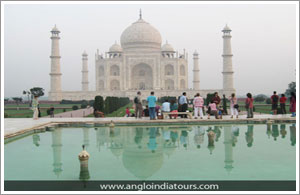 Taj Mahal - Agra :
Taj Mahal - Agra : In all, the Taj Mahal covers an area of 60 bighas, as the terrain gradually sloped from south to north, towards the river, in the form of descending terraces. At the southern point is the forecourt with the main gate in front and tombs of Akbarabadi Begum and Fatehpuri Begum, two other queens of Shah Jahan, on its south-east and south-west corners respectively called Saheli Burj 1 and 2.
On the second terrace is a spacious square garden, with side pavilions. It is divided into four quarters by broad shallow canals of water, with wide walkways and cypress avenues on the sides. The water channels and fountains are fed by overhead water tanks. These four quarters are further divided into the smaller quarters by broad causeways, so that the whole scheme is in a perfect char-bagh. The main tomb of the Taj is basically square with chamfered corners. The minarets here are detached, facing the chamfered angles (corners) of the main tomb on the main plinth. Red sandstone mosque on the western, and Mehman-Khana on the eastern side of the tomb provides aesthetically a clear colour contrast. The Taj has some wonderful specimens of polychrome inlay art both in the interior and exterior on the dados, on cenotaphs and on the marble jhajjhari (jali-screen) around them.
|
 Itmad-Ud - Daulah Tomb Agra :
Itmad-Ud - Daulah Tomb Agra : It is a Mughal mausoleum in the city of Agra in the Indian state of Uttar Pradesh. Often described as 'jewel box', sometimes called the 'Baby Tāj', the tomb of I'timād-ud-Daulah is often regarded as a draft of the Tāj Mahal. Along with the main building, the structure consists of numerous outbuildings and gardens. The tomb, built between 1622 and 1628 represents a transition between the first phase of monumental Mughal architecture - primarily built from red sandstone with marble decorations, as in Humayun's Tomb in Delhi and Akbar's tomb in Sikandra - to its second phase, based on white marble and pietra dura inlay, most elegantly realized in the Tāj Mahal. The mausoleum was commissioned by Nūr Jahān, the wife of Jahangir, for her father Mirzā Ghiyās Beg, who had been given the title of Itimād-ud-Daulah (pillar of the state). Mirzā Ghiyās Beg was also the grandfather of Mumtāz Mahāl (originally named Arjūmand Bāno, daughter of Asaf Khān), the wife of the emperor Shāh Jahān, responsible for the building of the Tāj Mahal.
|
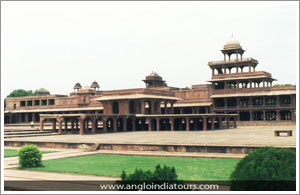 Fatehpur Sikri - Agra :
Fatehpur Sikri - Agra : Akbar (1556-1605), grandson of Babur, shifted his residence and court from Agra to Sikri, for a period of 13 years, from 1572 to 1585 to honour the Sufi Saint Sheikh Salim Chishti, who resided here (in a cavern on the ridge). Akbar revered him very much as the Saint had blessed him with a son who was named Salim in 1569. He raised lofty buildings for his use, and houses for the public. Thus grew, a great city with charming palaces and institutions. Akbar gave it the name of Fathabad and which in later days came to be known as “Fathpur Sikri”.Here practically, all Mughal institutions such as the ‘Ibadat-Khanah’, ‘Din-i-Ilahi’, ‘Tarikh-i-Ilahi’ , Jharokha-Darshan, the doctrine of Sulh-i-Kul and policy of liberal patronage to indigenous arts and literatures, were founded. It was also here that workshops of various handicrafts were established. Sikri was the first planned city of the Mughals. The sloping levels of the city were connected into terraces which were utilised for various complexes such as Jami masjid, Buland-Darwazah and tomb of Sheikh Salim Chishti; Khass Mahal, Shahi-Bazar, Mina-Bazar, the Panch-Mahal, Khwabgah, Diwan-i-Khass, Anup-Talao, Chaupar and Diwan-i-Am. The efficient system of drainage and water-supply adopted here suggest an extremely intelligent town-planning by the Mughal emperor.
|
 Boat Ride – Varanasi :
Boat Ride – Varanasi : The sacred city of Shiva stands graciously on the banks of river Ganga which are lined with an endless chain of stone steps known as the Ghats. Spread out in an area of around 7 kms along the river Ganga, these 90 odd ghats are dotted with a number of palaces, princely mansions, ashrams and mutts, ancient temples and shrines. Soon after the sunrise, the ceremonial steps of the ghats come alive with thousands of pilgrims performing interesting rites and rituals which continue through the day - People bowing to the rising Sun God, or taking a holy dip, ringing of the temple bells, chanting of devotional hymns combined with the heavy smoke billowing up from the funeral pyres – all these activities revolve around the sacred river Ganga and add magic and intrigue to the timeless city of Varanasi.
|
 Ghat of river Ganges – Varanasi :
Ghat of river Ganges – Varanasi : Located in Uttar Pradesh,Varanasi is popular across the country for being a holy place for the Hindus and for its sacred bathing Ghats by the side of the river Ganges. The innumerable ghats that dot the sacred place of Varanasi are also sometimes referred to as the ceremonial stairs all of whom are seen lined up on the western bank of the Ganges. Few of the Ghats are as old as hundred years scattered all over the city with more that 25,000 temples.
|
 Ghats - Varanasi :
Ghats - Varanasi : A walk along these ghats offers a unique and a pleasurable experience. Here one comes across saffron clad sadhus meditating with rudraksh malas in hand, priests chanting holy mantras, Brahmins sitting under palm leaves, tourists soaking in the entire atmosphere, little children playing cricket or flying kites, sacred cows roaming around and shops selling all sorts of souvenirs. Indeed, this unique relationship between the river Ganga, the Ghats and the city is the actual essence of Varanasi.
|
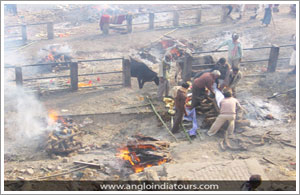 Cremation at River Ganges – Varanasi –
Cremation at River Ganges – Varanasi – On the glittering waters of the Ghats visitors can have the pleasure of a ravishing boat ride on its many Ghats. Some of the best Ghats that gives the visitors a chance to move around on the small boats on the Ganges are the ghats of Barnasangam, Panchganga, Dattatreya, Kedar, Scindia and Harishchandra Ghats besides the other major ghats. Devotees and visitors who come for a sacred tour to Varanasi never forget to avail the opportunity of having a boat encounter in the Ganges. It is advisable to take a boat tour in the early hours by the time when the Sun rises or before the setting of the Sun. From the middle of the Ganges at a far of distance the Ghats of Varanasi looks crowded and noisy and all colourful. The temple bells rings to far off distances. The small boats are a special interest for the young ones who crave to touch the cool waters from the boats and play with each other by sprinkling the water on to each others face.
|
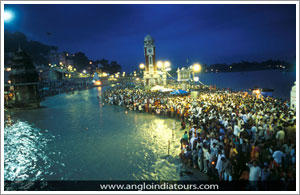 Aarti at Haridwar :
Aarti at Haridwar : To see the most breathtaking sight in Haridawar, come to the Harki pauri ghat in the evening, when the daily ritual of 'Maha Aarti' takes place. When the sun goes down, the most awaited activity of the evening Aarti takes places on the ghat. Ganges is decorated as a newly wedded bride and glows with fluorescence of the thousands and millions of diyas and marigold petals. The air seems to be filled with the rhythmic chants of the mantras and incense. Thousands of devotees sway in tempo and the religious fervency depicted is unimaginable. This activity goes son for six minutes after which the pilgrims scramble madly for the 'prasad' (holy offering)
|
|
|